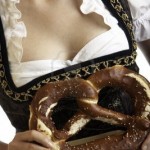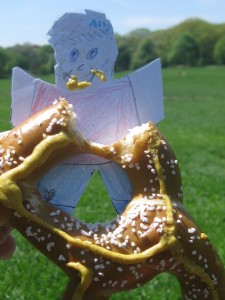Oktoberfest is drawing nigh (more quickly, actually, than October itself—the Munich festival begins next weekend), and though the most celebrated element of the festival is beer, I thought it might be worth delving into the history of another essential feature of both German and American festivities. “The crossbow competition?” you may ask. “The pork knuckles? The traditional hat sporting tufts of goat hair?” These are all good guesses. But in fact, I wish to focus your attention on the story of the pretzel.
Almost every fact in the pretzel’s twisted past (yes, I know–sorry) is up for debate. Though pretzels probably have their roots in the hard-baked biscuits that the Roman army carried into battle, the first of the familiar salted, knotted variety probably emerged on the European scene sometime in the 7th century, perhaps in conjunction with an egg-less Lent. The history, however, has become a little muddled, not least because Flemish painters saw pretzels as so fundamental that they painted them into depictions of the Last Supper. Confusing though this anachronistic tendency may be, I sort of appreciate their thinking: “If I like pretzels, who am I to deprive Jesus of a little nosh?”
Even the origins of the name are open to debate, with one camp (let’s call them the jewelry camp) saying that it comes from a Latin word for “bracelet” and another (let’s call them the pretzel fetishists) saying that it comes from the Latin word for “reward.”
Whatever its beginnings, there’s no doubt that some of the first European settlers in America came with pretzels in their pockets (first record of pretzels in the New World: 1652), and the food soon spread like wildfire. Philadelphians, in particular, took the food to heart, selling soft pretzels as street food as early as the 1820s. Some sources also have Philadelphians being the first to slather mustard on a pretzel, though I admit that this sounds an awful lot like casting aspersions on Germans. After all, they had both pretzels and mustard long before Philadelphia existed, so it’s hard to believe that no one considered the combination. Perhaps this is a Freedom Cabbage version of history. But I digress…
Lest you think all great moments in pretzel history happened in the past, allow me to remind you that, according to Datassential’s U.S. Chains & Independents MenuTrends Database, pretzel bread was the top growing bread between 2008 and 2012, with consumption increasing by a whopping 79%. Last weekend, I had a mushroom schnitzel sandwich on a pretzel roll (at previous Grub Match victor Lyon Hall), and the dense chewy marvel of it helped me to fully understand the pretzel bread’s meteoric rise. Coincidentally, it also increased my waistline and base drowsiness level by approximately 79%.
Whether you prefer your pretzels soft or crisp, shaped as twists or sticks, dipped in Cheez-whiz or fashioned into a roll, strung on a necklace or wielded by a pretty Oktoberfester in a dirndl, pretzels are a snack worthy of our respect.
Many thanks to www.foodtimeline.org for most of these facts.


